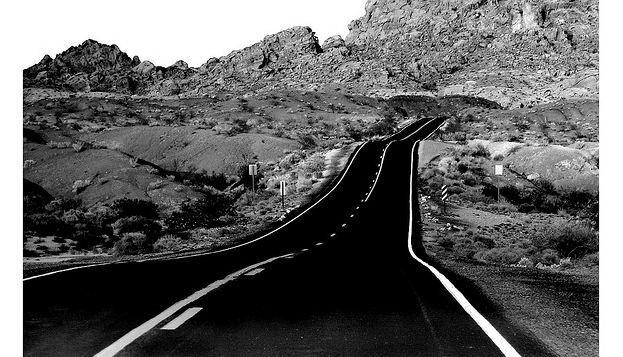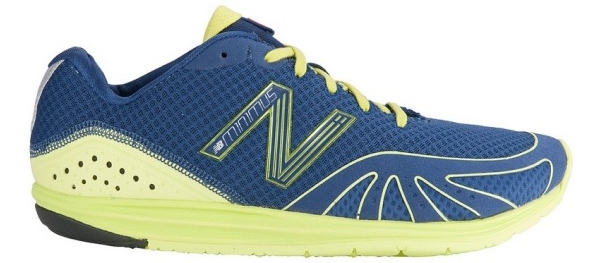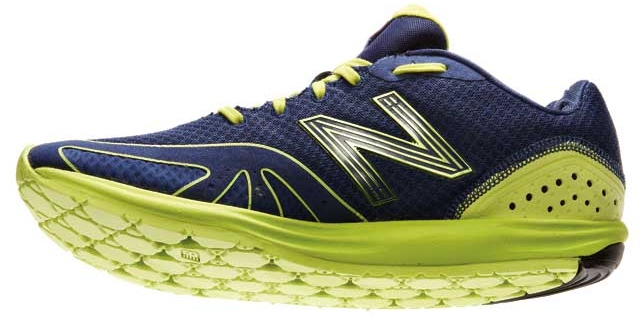Every runner needs training tools – workouts, gear, or elements of running that accomplish a very specific goal.

Hill sprints are a tool that build leg power and injury resistance.
A foam roller is a tool that provides pain…I mean, self-massage, and helps to prevent injuries.
Barefoot strides is a training tool that increases efficiency and lower leg strength.
The long run is a tool that builds endurance and helps you go longer at a faster pace.
You get the idea.
For two months, I used the New Balance Minimus Road as a training tool to build my lower leg strength and make the transition to racing flats easier.
And I’m glad I did! Now that I’m in the midst of my competition phase of training with several races and lots of workouts in flats, I’m feeling great.
My arches, soleus’, and calves get sore very easily. I’m an overpronator and I have low arches – not a good combo when you’re trying to run fast in light shoes. With less than ideal biomechanics, my lower legs are put under more stress and constant damage control is a necessity.
Fortunately, before I started running in my Nike Zoom Streak flats, I was developing lower leg and foot strength using the Minimus Roads. They made the transition a lot easier and virtually eliminated the stiffness I’ve grown accustomed to when running in racing shoes.
Today, I’ll give you an overview of the Minimus and show you how to use these shoes to build your leg strength and make the transition to flats easier.
New Balance Minimus Road: First Impressions

At 8 ounces with a 4mm heel-toe drop, the Minimus sits close to the ground but isn’t super light like other minimalist alternatives. This works great for me because I can’t run significant mileage in a shoe much less than about 8 ounces anyway. Take for example the Merrell Trail Gloves – I ran 4 minutes in them and called it a day…
Even though the shoe isn’t feather-light, the feel of it on your foot is very glove-like. With a soft, plush upper that’s designed to be worn without socks, it’s incredibly comfortable. There’s also a collar around the heel which prevents irritation around the Achilles tendon. I was dealing with some of this from my ASICS Speedstars so the padding was a welcome relief.
When running in the Minimus Road, I found the ride fairly firm. I like that, so it worked well. But it was clear that a natural-feeling midfoot strike was easy in this shoe. I typically have a slight heel strike but the Minimus made that nearly impossible. The low heel-toe drop can be credited for this, but I also think it’s because of the shape of the shoe’s heel.
You’ll see in the picture above that the bottom of the heel is actually angled forward underneath the back of the shoe. Pete Larson called this an “undercut heel” and it mimics the shape of your barefoot heel. Unlike a flared or more neutral heel, it’s better at encouraging a midfoot strike and I loved the groundfeel it helped give me on both roads and trails.
Like most minimalist shoes, the New Balance Minimus Road has a wide toebox that lets your toes spread out – no black toenails or blisters here! During my first few runs, it felt like the shoe wasn’t tight enough on my foot. But I quickly learned that the shoe was fitted properly and I just wasn’t used to the freedom and toe mobility that the Minimus provides. Now I love it.
With my low arches, I don’t like a shoe that has significant arch support because it makes me sore and gives me blisters. Luckily with the NB Minimus Road, the insole felt flat – just what you want in a minimalist shoe that’s trying to mimic the barefoot condition.
How I Used the NB Minimus Road to Get Strong

The Minimus Road was used in my training very strategically: I was at a point where I was transitioning from higher mileage and longer workouts to less mileage and faster, shorter workouts in racing flats. With three (or more) races in my fall season, I needed to condition my body to running in flats.
The worst thing you can do is start an interval workout in your racers with no prep. Your lower legs will get trashed. So I started methodically acclimating to “less shoe” by wearing the Minimus Roads for 4-5 mile easy runs every week. I used the principle of progression to gradually strengthen my feet.
Here’s what that progression looked like on a weekly basis:
- one 4-5 mile run
- one 4-5 mile run with 4 x 20-30sec surges
- one 5 mile run with surges, plus another 5 mile run as a double session (two runs in one day)
- one 5 mile run with hill sprints, plus another 5 mile run as a double session
This occurred over 6-8 weeks so some of these steps were repeated. Adaptation takes longer than you think and it took weeks for me to run comfortably in the Minimus.
Now the real secret sauce in this progression is the combination of surges and hill sprints in the later weeks. 3-5 miles of fast running in flats introduces significant trauma to the feet and lower legs, but the smaller doses of even faster running helped acclimate my legs to those demands. In his book Run Faster, elite coach Brad Hudson refers to this as the repeated bout effect.
When I started running workouts in the Streak XC’s, I barely noticed the soreness that’s usually an unfortunate reality for me.
A word of caution: running hill sprints – or maximum effort uphill sprints – in minimalist trainers like the NB Minimus Road, is an advanced training technique. It puts tremendous stress on your feet and lower legs so make sure you’re ready for it. You’ll see in the progression above that hill sprints were the last thing I added.
How to Use Minimalist Tools
I was hesitant when I bought the Minimus Road’s because I had tried on the trail version and those felt awkward on my feet. So I ordered these with reservations, but at the end of the day I absolutely loved them. The glove-like fit, slightly firm ride, undercut heel, neutral foot bed, and substantial groundfeel make this a perfect minimalist tool (for me, at least).
You may prefer another type of minimalist tool – maybe barefoot running, barefoot strides, or even just wearing your racing flats on an easy run every 1-2 weeks.
No matter what you choose, a small amount of minimalist training every week can help strengthen your feet and prevent overuse injuries from lower leg weaknesses.
You can buy the Minimus Road on Amazon here (go with the white/blue colors – so awesome).
For fun, here is a New Balance promo video of the NB Minimus Trail starring ultramarathoner Anton Krupicka. It’s not exactly the same shoe, but they’re very similar and I absolutely love this video. Makes you want to run a lot in the mountains doesn’t it?